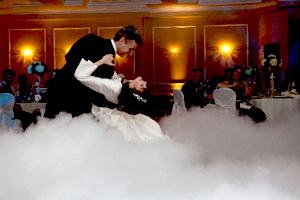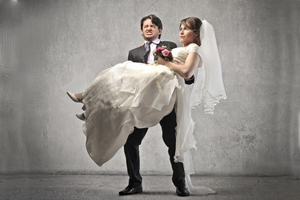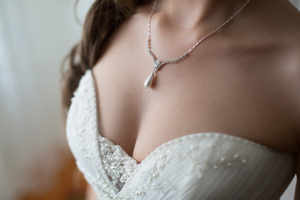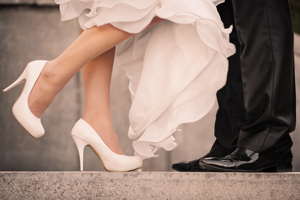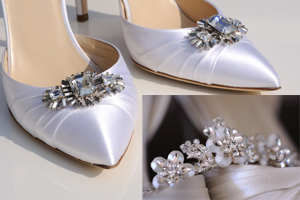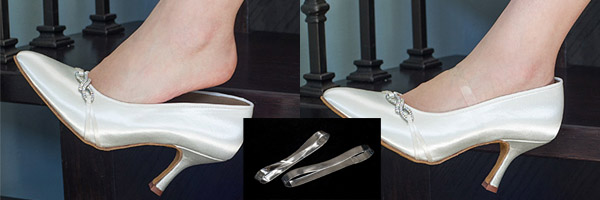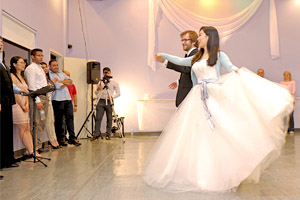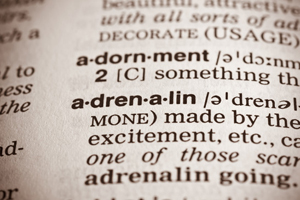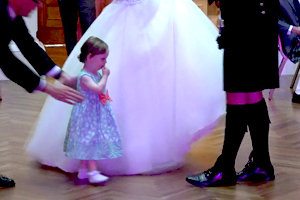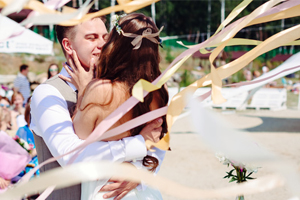First dance suggestions for a harmonious and nonviolent wedding dance experience
wedding dance ideas, choreography
First Wedding Dance Dancer’s Oath
Do not, under any circumstances, suggest, criticize, or even compliment your partner!
Fine print:
If it becomes unbearable, you should talk to your wedding dance choreographer (who is also your dance lawyer, dance policeman, dance doctor, and dance instructor!)
Don’t Use Artificial Fog.
We discourage using fog because, during the dance, the audience will not see the couple.
Fog might also confuse and visually impair the couple themselves during the dance. This might be even more uncomfortable if the groom is unused to dancing with the bride while she is in her wedding dress.
Banquet halls may surprise couples by introducing artificial fog during the dance without first consulting the dancers. Be sure to inform them beforehand if you want to avoid this on your wedding day.
Dance First – Eat Later
After your happy (but stressful) day, you will be tempted to sit down, rest and sample that delicious-looking buffet you’ve been planning for months. A word to the wise;
Dance first, eat later! Once you’ve started “just a taste,” you probably won’t be able to stop, and once you’re full, you probably won’t be able to dance. At least not the way you’ve been practicing. Dance your dance, impress your audience, and then sit down, relax, and eat according to your heart’s desire. You deserve it!
Also, refrain from alcoholic beverages before your dance. Drinking to boost your bravery never works and leads to disappointing results.
Wedding Outfits
Men’s Outfit
There are a couple of things to consider with the men’s outfit.
First, men’s suits are traditionally buttoned up with the bottom button open. You must pay attention to how the suit sits on you while dancing. During certain dance moves, such as twirling your partner, if the suit does not sit well on you and lacks arm and elbow freedom, it will bunch up on the shoulder, creating an ugly, bulky effect. It may also restrict arm and shoulder movement and be uncomfortable during the dance.
If you choose to wear a vest without a jacket during your wedding dance, you may want to consider getting a vest that is longer than your belt line and covers it from the back during dancing. If you bend even slightly, your shirt will come untucked from your pants and bulk around between the short vest and belt. This will not be a visual issue if your vest is longer.
You might also like to remember that vests with no adjusting belts on the back and a plain, straight back are more aesthetically pleasing.
Strapless Dresses
During previous years, brides have shared some personal wedding experiences regarding their strapless dresses. On more than one occasion, brides tended to lose weight while leading up to their wedding day. Unfortunately, they did not consider re-adjusting their dresses and ended up stuffing the tops, only to have the stuffing fall out during their dance performances. As you can imagine, this could bee not really pleasant.
During dress fittings, brides might try the steps they learned for their wedding dance routine (choreography) to see if they are comfortable and safe. If the bride has any concerns or difficulties, she should contact their dance instructor to adjust their dance pattern.
If you are planning to continue with Ballroom Dance Classes as your future family hobby, it is a good idea to get real dance shoes for your Wedding First Dance. They are much lighter, softer, and more glamorous than regular shoes.
Men’s shoes are usually quite stiff, so it might be a good idea to get started by breaking them in on a clean dance floor beforehand.
Wedding Shoes
As with the wedding gown, it would also be quite valuable for you to dance a few (or all) dance classes with your actual wedding shoes or a quite similar pair with the same size heels. This will make it much easier for you to cope with your wedding day.
For ladies who aren’t used to wearing high heels, this is the best time for you to practice. It would be best to start wearing heels as soon as possible to train your feet and calf muscles to adapt. Otherwise, they will be very sore on your wedding day.
Many brides reach the moment of their wedding dance and are so tired they end up dancing barefoot or in flats. While it is understandable that you are exhausted after so much pre-wedding planning and all day on your feet on your actual wedding day, do not “heel-down.” What that means is, perhaps, consider wearing (and having your dress adjusted to) lower heels for the whole day and then wearing higher heels for the actual dance. This way, your feet won’t be killing you, and not only that but your dress will, ever so slightly, be lifted off the floor. This will allow for ease of movement on the floor and prevent you and your partner from stepping on your dress and tripping, which is more likely to happen when you “heel-down” instead of up.
If you plan to continue with Ballroom Dance Classes as your future family hobby, getting authentic dance shoes for your Wedding First Dance is a good idea. They are much lighter, softer, and more glamorous than regular shoes.
Men’s shoes are usually quite stiff, so it might be a good idea to get started by breaking them in on a clean dance floor beforehand.
Wedding Shoes With Embellishments
Beware of embellishments on your wedding shoes; they may catch onto your dress and either trip you or ruin it. Since it is quite possible that you will not be practicing dancing in your wedding shoes and dress, anything unexpected could also throw you off your routine and ruin your dance. Remember that although you want the perfect pair of shoes for your ideal day, nobody will focus on the shoes underneath your dress!
Wedding Shoe band
Shoe size can be a hassle. We’ve all been there. You try the shoes for a few minutes at the store; you like them, you buy them. A few weeks later, you can show them off at your best friend’s wedding, but during your first moves on the dance floor, the left shoe comes flying off and hits your date on the cheek! Okay, maybe not, but to be safe, try our see-through shoe bands if they are a bit loose. These will keep your shoes safe, secure and suitable where they should be, on your feet!
Showbands are available upon request. Please feel free to contact the studio if you’d like more information.
Contact Lenses
Please bring your contacts to each lesson so you can practice with them and get used to having them while you dance.
If you are used to wearing glasses but are planning to wear contact lenses during the wedding, please give yourself enough time to adapt to them. Your eyes and brain need to get used to them to adjust your balance. Often, contacts delay your reaction because they are “floating” on the eye’s surface and do not allow you to see things exactly at the time they occur. There can be a slight delay, making keeping the movement’s balance and coordination challenging.
Comfortable Dancing
Smaller steps mean more comfortable dancing. A common misconception about dancing is the need to take large strides. Your steps should be as close to natural walking as possible to make your dance safer, more fluid, and more enjoyable. At YourWeddingDance.ca, we focus on techniques that prioritize your comfort and confidence, ensuring your first dance feels natural and effortless.
Men often worry about forgetting their dance patterns. There’s no need to add extra stress on your wedding day. If you forget a move, don’t be afraid to stop and start again from a step you know well. Even in ballroom dance competitions, couples sometimes stop and restart when necessary, which isn’t a mistake. Remember, good dancers are not those who never make mistakes but those who don’t let them show.
At YourWeddingDance.ca, we’ll guide you through techniques to handle these moments gracefully, helping you turn any misstep into part of the magic. Visit our homepage to learn how our personalized lessons can make your first dance a highlight of your special day. Let’s make your dance as comfortable and memorable as your love story.
Dance Practice
- Practice in different rooms. Getting used to a specific room makes adapting to a different size and layout on your wedding day more challenging. At YourWeddingDance.ca, we emphasize the importance of versatility so you can feel confident no matter the setting.
- Have your lessons while wearing one of our practice wedding gowns or skirts. It is helpful for both of you to simulate how the bride will look on the wedding day. Practicing in attire similar to your wedding outfit provides numerous benefits, including:
A. Getting used to NOT LOOKING DOWN! One of the most common habits during dance practice is when couples look at their or their partner’s feet while dancing. First, this looks hesitant and distracting, preventing proper lead and follow. Second, it does not portray confidence. Couples should look up at each other or their guests, not down at their feet.
B. Getting used to dancing in a similar-style dress. This prevents distractions on the wedding day, such as figuring out how to move in a style of clothing you’ve never worn before. Many brides have big, bulky, or tight-fitting dresses, such as mermaid-style gowns that limit movement.
C. Wearing similar dresses during practice helps choreograph a dance tailored to your dress and style. For example, a bulky dress with lots of fabric may require appropriate bustling and learning to use the fabric for embellishments that add flair and grace to your dance. During lessons at YourWeddingDance.ca, we help you master this so you’ll feel confident and elegant on your big day.
- You can take advantage of monthly practice opportunities. Once a month, we offer all our students who are yet to be married the chance to practice their dance in front of other studio students and wedding couples. Performing your routine in a supportive environment builds confidence and provides an experience equivalent to two or three private lessons.
- Practice on your wedding day! Find five to ten minutes before guests begin arriving to practice your dance in the actual room. Run through your routine twice without music to refresh the pattern and adjust to the space. Avoid over-practicing, as it can create tension and emotional exhaustion.
Discover how YourWeddingDance.ca can help make your first dance a cherished memory. Visit our homepage to learn more about our private lessons, group classes, and tailored choreography. Let’s create a magical dance together!
Take Notes!
Consider taking notes during class to remember the steps you’ve just learned. Everyone has their preferred way of retaining information—some write notes, others draw diagrams, and some take pictures or record videos of the dance at the end of the class. Choose the method that works best for you! At YourWeddingDance.ca, we encourage anything that helps you practice effectively at home and progress as quickly as possible before your wedding day.
Visit our homepage to learn more about our personalized wedding dance lessons, tips for effective practice, and how we can help you make your first dance unforgettable. Let us guide you every step of the way to create a dance you’ll cherish forever.
Adrenalin
The dance performance will almost always excite and invigorate you, but it may also make you feel nervous. This is primarily due to the adrenaline pumping through your body. On your wedding day, many people feel pressure to have everything come together perfectly, which can lead to stress about performing for an audience.
It’s important to remember that adrenaline can be both your best friend and your worst enemy; ultimately, how you respond to it is your choice. Being aware of your inner state is crucial. An adrenaline rush can cause disorientation or a blanking out, which may lead to misinterpreting the musical rhythm. This can cause you to dance at a different speed from the music, leading to confusion in your movements.
To manage this, if you feel the urge to speed up, do the exact opposite—try to slow down. Avoid the temptation to chase the beat or accelerate your movements. Instead, wait for the next beat and align your actions with it. Focus on the rhythm to maintain your pace on the dance floor.
Children on the Dance Floor
Please be aware that parents are often distracted and not paying attention to their youngsters’ whereabouts. Children can be fascinated by the glittering wedding dress and glamorous allure of the dancing couple. They may be tempted to come close and touch, watch or even join in the excitement. Behind the big dress and focus on your spotlight moment, you might not notice them standing there. Just remember to ask the DJ to remind parents to watch for their kids and maybe have someone keep an eye out.
Changes to the Dance
We recommend avoiding last-minute changes to your choreography one or even two weeks before your wedding day. On average, couples start taking classes around three months before their wedding day and get used to their patterns. Muscle memory is already working to its advantage, and changing steps too close to the performance day will create a significant chance of confusion, leading to mistakes.
Support
Try assigning a significant role to a few in your bridal party to cheer loudly during your performance. Guests are often confused between a dance performance and a music performance. At a music performance, the audience will be quiet until the piece of music is done, whereas, at a dance performance, they will cheer the dancers on throughout the show. Your selected guests will serve as an example to your audience and provide you with emotional support and encouragement as you dance.
Your wedding dance is a gift!
Remember that your dance is a gift to each other and your guests. Each pattern that you learn is a meaningful, visual representation of your love story. Your teacher will explain that your dance isn’t just several steps during your lessons, but each move will have purpose and meaning that will make it easier to understand and memorize. Please also remember that your audience won’t know your next move, so you should consider any mistake as a variation of your step and cover for each other. Don’t show any facial or body language that may betray the fact that you’ve done something different. There is absolutely no need to place the unnecessary pressure of a professional ballroom dance performance on your shoulders.
Keep It Secret!
We have had many students who have preferred to refrain from letting others know about taking dance classes. That helped avoid the extra pressure and, of course, create more of a surprise!
We would also be delighted to receive your tips and suggestions after your dance classes and/or wedding.
Please specify, though, what you would be comfortable with us sharing on the website.
George (416) 358-5595

